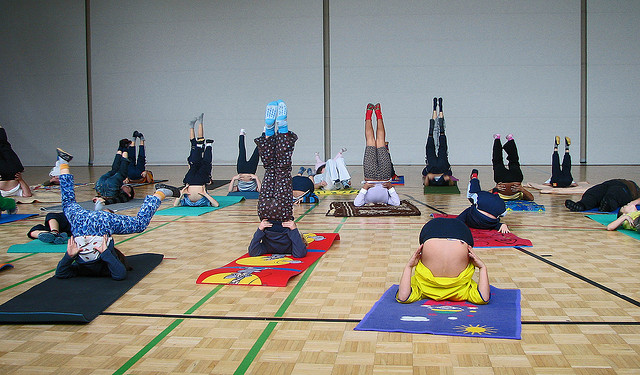Integrating yoga into academic environments is gaining more traction as science has begun to support what we yogis already know: yoga has profound positive emotional, academic and physical impacts on students, teachers and school communities.
As we continue to bring yoga into schools, we will still encounter barriers. However, thanks to the California appeals court ruling that yoga taught in a public school does not violate the religious rights of students or their parents, as well as the continued scientific evidence supporting yoga in schools, the barrier is shifting.
I have found that the day-to-day concerns expressed by classroom teachers are less about religious rights, and more about their own ability to practice and teach yoga.
This leads me to wonder, how do we hook the “I don’t do yoga” crowd? What is it about yoga that stops these educators from even discussing yoga’s proven benefits for kids and adults alike? Here are some thoughts on how we can make yoga more accessible for classroom teachers.
Paschimottanasana? You mean touch my toes?
My dear sister, who is a math teacher and an avid runner, can sometimes be persuaded to attend yoga class with me. She struggles through the classes trying to follow along with the Sanskrit instructions and employ her ujjayi breath, although she isn’t really sure what that is.
She is always beautifully authentic and reports that her biggest beef with yoga classes is that she doesn’t know what she is supposed to do, so she looks at me the whole time for cues. She is definitely not connecting with her body and breath when she is looking around the room trying to figure out what the hell is going on. No wonder she never wants to go to class with me.
I take her feedback about yoga classes and I try to put myself in a classroom teachers’ shoes. What if one day I was suddenly asked to attend a professional development on how to incorporate quantum physics in my yoga class? I would go to the training and find they are talking about kinematical postulates. I’d already be overwhelmed, wondering why I have to learn this, and I’d tune out. I would surely not apply this in my next yoga class.
With all due respect to the poetic art of yoga language, let’s keep it simple while working in non-traditional settings. “Find tadasana” can be rephrased as “stand up tall.” We can give simple, direct, clear and meaningful cues that get people into their bodies without all the fluff. If we don’t use language that classroom teachers can understand, they are not going to follow and they are certainly not going to incorporate yoga into their classrooms.
Can I wear my shoes?
During my yoga teacher training, I was assisting a seasoned teacher in her class. One day, a woman rushed into the class late. We all know the feeling of walking in late to a yoga class—that frazzled feeling when you think everyone in the room hates you for interrupting their centering time. On top of that, she had never been to the studio before and had brought her purse and shoes into the studio and left them in the corner instead of the lobby.
She rolled out her mat and started to jump in with the group. I could tell she was starting to relax when my mentor teacher asked me to tell her to put her shoes in the lobby. My stomach dropped.
This woman was already feeling unsure of herself, being a beginner to yoga and the studio. As I asked her to get up from her mat and take her shoes into the lobby, making another interruption in class, I was sure I would never see her at that studio again. I hoped that the experience did not turn her off to yoga completely.
Yes, we need to ensure the cleanliness of the studio, but yoga sometimes seems inaccessible to people because they aren’t sure what the “rules” are and they don’t want to be embarrassed. The kids and teens I work with have much less of a filter, so I get genuine questions from them. Can I wear my shoes? What if my feet stink? Can we talk? What if I fart? Will I get in trouble if I laugh?
We know that adults have these same questions. Let’s allow people to carry out their yoga practice in the way that feels safest to them, physically and emotionally.
Our schools need yoga and we can’t have yoga in schools without classroom teachers on board. Let’s make yoga simple, understandable and accessible for educators. Let’s meet “I don’t do yoga” classroom teachers at their comfort level—shoes in the corner and all.
Relephant:
How Yoga Can Save Our Schools.
~
Author: Lauren Greenspan
Editor: Catherine Monkman
Photo: Ilona/Flickr







Read 1 comment and reply